Economic and Social Challenges of an Ageing Population in Australia
VerifiedAdded on 2021/08/23
|7
|2080
|49
Essay
AI Summary
This essay examines the multifaceted challenges posed by Australia's ageing population. It highlights the increasing strain on the healthcare system due to age-related diseases and chronic conditions, the rising dependency ratio, and the potential economic impacts. The essay discusses the demographic shifts, including declining fertility rates and increased life expectancies, that contribute to the ageing population. It analyzes the fiscal implications, the need for healthcare professionals, and the government's efforts to address these challenges through policy and financial planning. The analysis also touches upon lifestyle factors, such as healthy living and advanced medical treatments, that influence the ageing population. Ultimately, the essay argues that while the ageing population presents significant challenges, proactive measures and strategic planning are essential to mitigate the negative impacts and ensure a sustainable future for Australia.
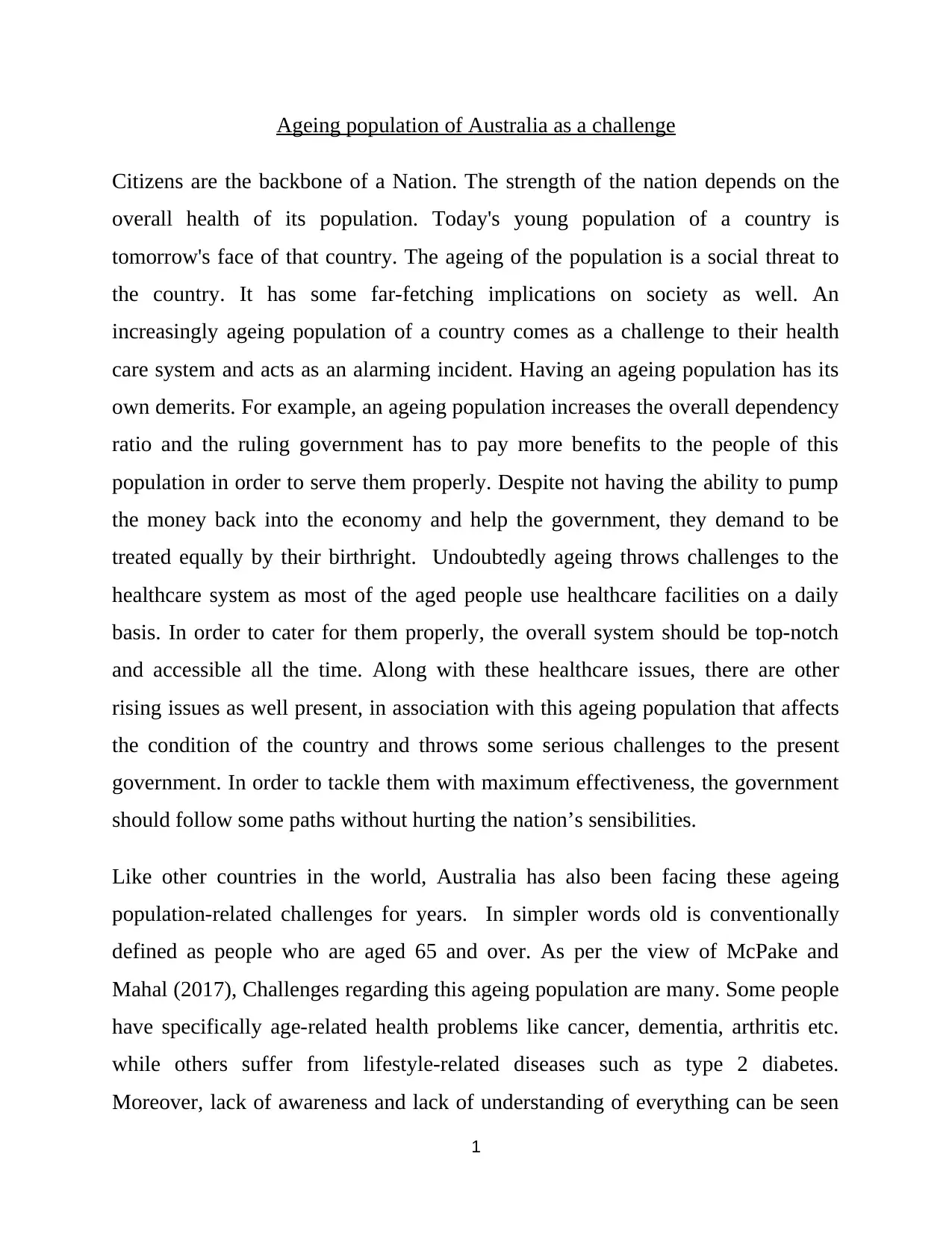
Ageing population of Australia as a challenge
Citizens are the backbone of a Nation. The strength of the nation depends on the
overall health of its population. Today's young population of a country is
tomorrow's face of that country. The ageing of the population is a social threat to
the country. It has some far-fetching implications on society as well. An
increasingly ageing population of a country comes as a challenge to their health
care system and acts as an alarming incident. Having an ageing population has its
own demerits. For example, an ageing population increases the overall dependency
ratio and the ruling government has to pay more benefits to the people of this
population in order to serve them properly. Despite not having the ability to pump
the money back into the economy and help the government, they demand to be
treated equally by their birthright. Undoubtedly ageing throws challenges to the
healthcare system as most of the aged people use healthcare facilities on a daily
basis. In order to cater for them properly, the overall system should be top-notch
and accessible all the time. Along with these healthcare issues, there are other
rising issues as well present, in association with this ageing population that affects
the condition of the country and throws some serious challenges to the present
government. In order to tackle them with maximum effectiveness, the government
should follow some paths without hurting the nation’s sensibilities.
Like other countries in the world, Australia has also been facing these ageing
population-related challenges for years. In simpler words old is conventionally
defined as people who are aged 65 and over. As per the view of McPake and
Mahal (2017), Challenges regarding this ageing population are many. Some people
have specifically age-related health problems like cancer, dementia, arthritis etc.
while others suffer from lifestyle-related diseases such as type 2 diabetes.
Moreover, lack of awareness and lack of understanding of everything can be seen
1
Citizens are the backbone of a Nation. The strength of the nation depends on the
overall health of its population. Today's young population of a country is
tomorrow's face of that country. The ageing of the population is a social threat to
the country. It has some far-fetching implications on society as well. An
increasingly ageing population of a country comes as a challenge to their health
care system and acts as an alarming incident. Having an ageing population has its
own demerits. For example, an ageing population increases the overall dependency
ratio and the ruling government has to pay more benefits to the people of this
population in order to serve them properly. Despite not having the ability to pump
the money back into the economy and help the government, they demand to be
treated equally by their birthright. Undoubtedly ageing throws challenges to the
healthcare system as most of the aged people use healthcare facilities on a daily
basis. In order to cater for them properly, the overall system should be top-notch
and accessible all the time. Along with these healthcare issues, there are other
rising issues as well present, in association with this ageing population that affects
the condition of the country and throws some serious challenges to the present
government. In order to tackle them with maximum effectiveness, the government
should follow some paths without hurting the nation’s sensibilities.
Like other countries in the world, Australia has also been facing these ageing
population-related challenges for years. In simpler words old is conventionally
defined as people who are aged 65 and over. As per the view of McPake and
Mahal (2017), Challenges regarding this ageing population are many. Some people
have specifically age-related health problems like cancer, dementia, arthritis etc.
while others suffer from lifestyle-related diseases such as type 2 diabetes.
Moreover, lack of awareness and lack of understanding of everything can be seen
1
Paraphrase This Document
Need a fresh take? Get an instant paraphrase of this document with our AI Paraphraser
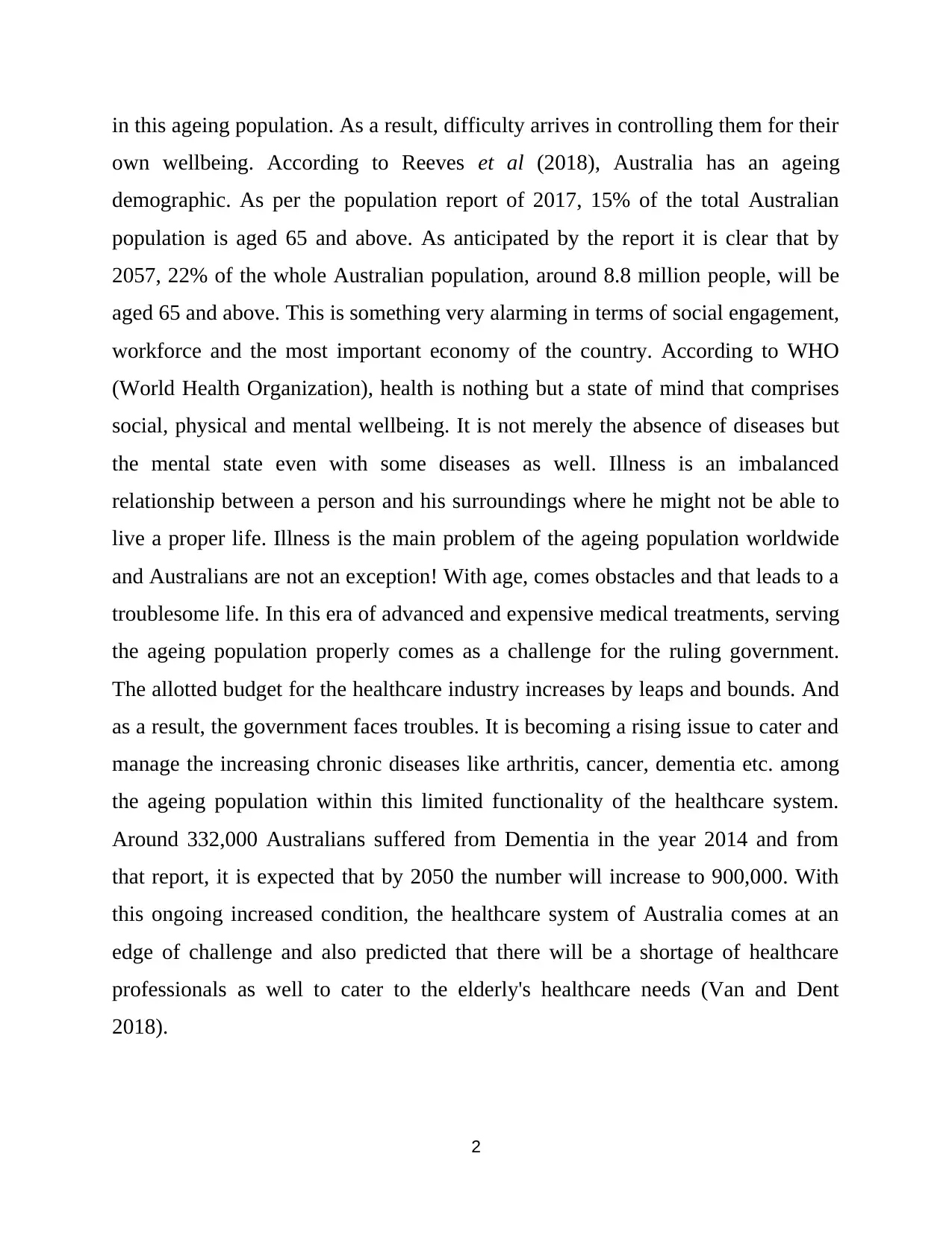
in this ageing population. As a result, difficulty arrives in controlling them for their
own wellbeing. According to Reeves et al (2018), Australia has an ageing
demographic. As per the population report of 2017, 15% of the total Australian
population is aged 65 and above. As anticipated by the report it is clear that by
2057, 22% of the whole Australian population, around 8.8 million people, will be
aged 65 and above. This is something very alarming in terms of social engagement,
workforce and the most important economy of the country. According to WHO
(World Health Organization), health is nothing but a state of mind that comprises
social, physical and mental wellbeing. It is not merely the absence of diseases but
the mental state even with some diseases as well. Illness is an imbalanced
relationship between a person and his surroundings where he might not be able to
live a proper life. Illness is the main problem of the ageing population worldwide
and Australians are not an exception! With age, comes obstacles and that leads to a
troublesome life. In this era of advanced and expensive medical treatments, serving
the ageing population properly comes as a challenge for the ruling government.
The allotted budget for the healthcare industry increases by leaps and bounds. And
as a result, the government faces troubles. It is becoming a rising issue to cater and
manage the increasing chronic diseases like arthritis, cancer, dementia etc. among
the ageing population within this limited functionality of the healthcare system.
Around 332,000 Australians suffered from Dementia in the year 2014 and from
that report, it is expected that by 2050 the number will increase to 900,000. With
this ongoing increased condition, the healthcare system of Australia comes at an
edge of challenge and also predicted that there will be a shortage of healthcare
professionals as well to cater to the elderly's healthcare needs (Van and Dent
2018).
2
own wellbeing. According to Reeves et al (2018), Australia has an ageing
demographic. As per the population report of 2017, 15% of the total Australian
population is aged 65 and above. As anticipated by the report it is clear that by
2057, 22% of the whole Australian population, around 8.8 million people, will be
aged 65 and above. This is something very alarming in terms of social engagement,
workforce and the most important economy of the country. According to WHO
(World Health Organization), health is nothing but a state of mind that comprises
social, physical and mental wellbeing. It is not merely the absence of diseases but
the mental state even with some diseases as well. Illness is an imbalanced
relationship between a person and his surroundings where he might not be able to
live a proper life. Illness is the main problem of the ageing population worldwide
and Australians are not an exception! With age, comes obstacles and that leads to a
troublesome life. In this era of advanced and expensive medical treatments, serving
the ageing population properly comes as a challenge for the ruling government.
The allotted budget for the healthcare industry increases by leaps and bounds. And
as a result, the government faces troubles. It is becoming a rising issue to cater and
manage the increasing chronic diseases like arthritis, cancer, dementia etc. among
the ageing population within this limited functionality of the healthcare system.
Around 332,000 Australians suffered from Dementia in the year 2014 and from
that report, it is expected that by 2050 the number will increase to 900,000. With
this ongoing increased condition, the healthcare system of Australia comes at an
edge of challenge and also predicted that there will be a shortage of healthcare
professionals as well to cater to the elderly's healthcare needs (Van and Dent
2018).
2
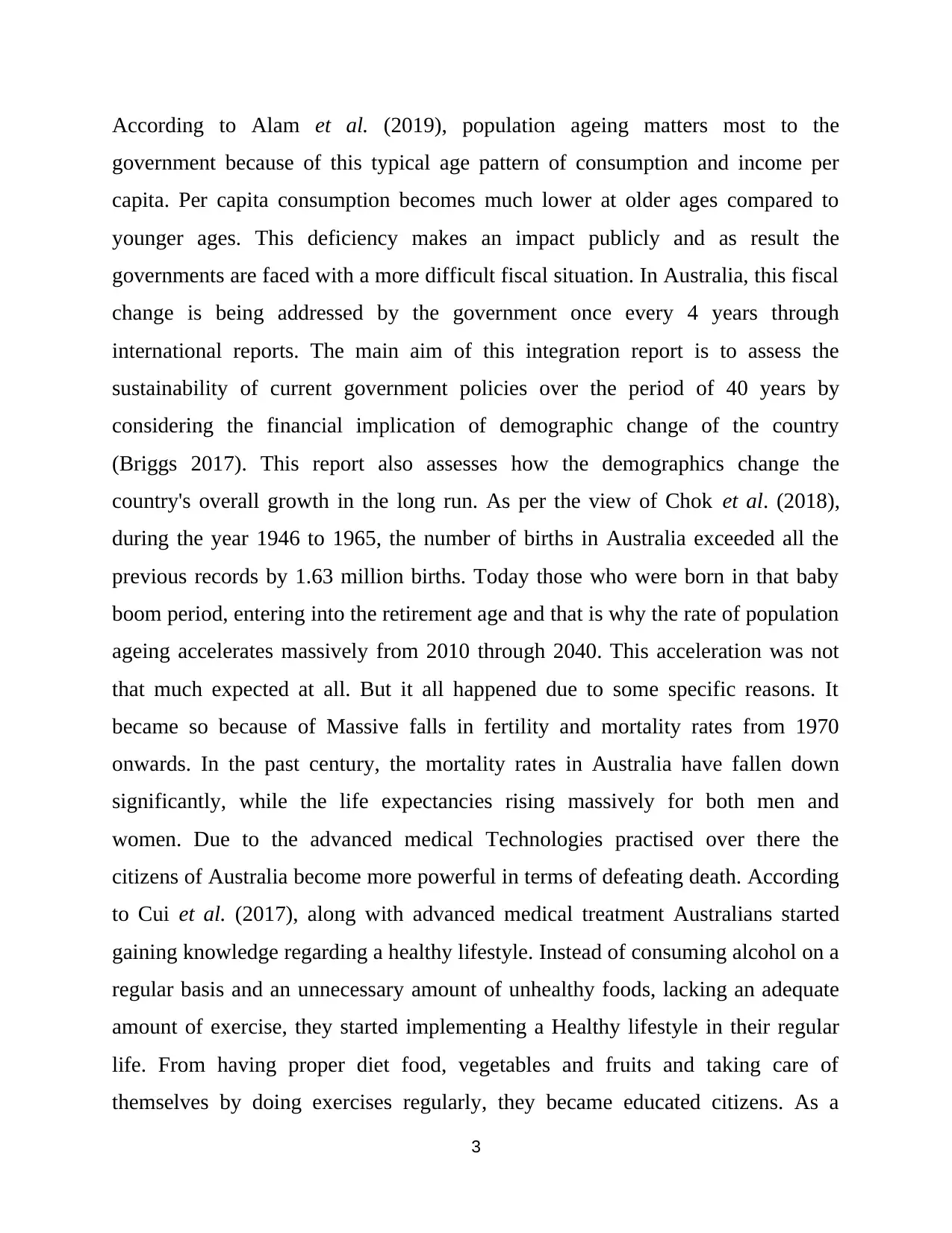
According to Alam et al. (2019), population ageing matters most to the
government because of this typical age pattern of consumption and income per
capita. Per capita consumption becomes much lower at older ages compared to
younger ages. This deficiency makes an impact publicly and as result the
governments are faced with a more difficult fiscal situation. In Australia, this fiscal
change is being addressed by the government once every 4 years through
international reports. The main aim of this integration report is to assess the
sustainability of current government policies over the period of 40 years by
considering the financial implication of demographic change of the country
(Briggs 2017). This report also assesses how the demographics change the
country's overall growth in the long run. As per the view of Chok et al. (2018),
during the year 1946 to 1965, the number of births in Australia exceeded all the
previous records by 1.63 million births. Today those who were born in that baby
boom period, entering into the retirement age and that is why the rate of population
ageing accelerates massively from 2010 through 2040. This acceleration was not
that much expected at all. But it all happened due to some specific reasons. It
became so because of Massive falls in fertility and mortality rates from 1970
onwards. In the past century, the mortality rates in Australia have fallen down
significantly, while the life expectancies rising massively for both men and
women. Due to the advanced medical Technologies practised over there the
citizens of Australia become more powerful in terms of defeating death. According
to Cui et al. (2017), along with advanced medical treatment Australians started
gaining knowledge regarding a healthy lifestyle. Instead of consuming alcohol on a
regular basis and an unnecessary amount of unhealthy foods, lacking an adequate
amount of exercise, they started implementing a Healthy lifestyle in their regular
life. From having proper diet food, vegetables and fruits and taking care of
themselves by doing exercises regularly, they became educated citizens. As a
3
government because of this typical age pattern of consumption and income per
capita. Per capita consumption becomes much lower at older ages compared to
younger ages. This deficiency makes an impact publicly and as result the
governments are faced with a more difficult fiscal situation. In Australia, this fiscal
change is being addressed by the government once every 4 years through
international reports. The main aim of this integration report is to assess the
sustainability of current government policies over the period of 40 years by
considering the financial implication of demographic change of the country
(Briggs 2017). This report also assesses how the demographics change the
country's overall growth in the long run. As per the view of Chok et al. (2018),
during the year 1946 to 1965, the number of births in Australia exceeded all the
previous records by 1.63 million births. Today those who were born in that baby
boom period, entering into the retirement age and that is why the rate of population
ageing accelerates massively from 2010 through 2040. This acceleration was not
that much expected at all. But it all happened due to some specific reasons. It
became so because of Massive falls in fertility and mortality rates from 1970
onwards. In the past century, the mortality rates in Australia have fallen down
significantly, while the life expectancies rising massively for both men and
women. Due to the advanced medical Technologies practised over there the
citizens of Australia become more powerful in terms of defeating death. According
to Cui et al. (2017), along with advanced medical treatment Australians started
gaining knowledge regarding a healthy lifestyle. Instead of consuming alcohol on a
regular basis and an unnecessary amount of unhealthy foods, lacking an adequate
amount of exercise, they started implementing a Healthy lifestyle in their regular
life. From having proper diet food, vegetables and fruits and taking care of
themselves by doing exercises regularly, they became educated citizens. As a
3
⊘ This is a preview!⊘
Do you want full access?
Subscribe today to unlock all pages.

Trusted by 1+ million students worldwide
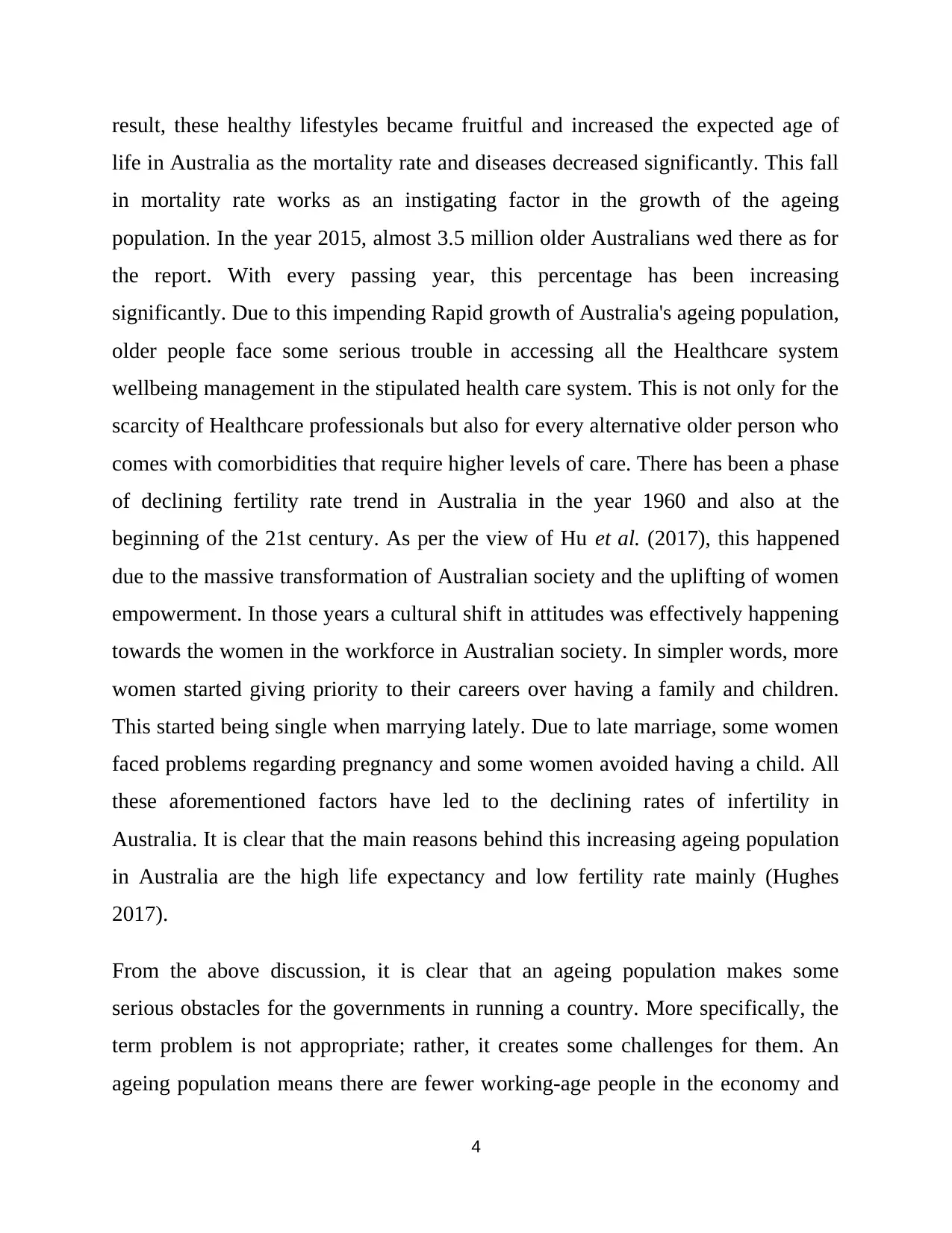
result, these healthy lifestyles became fruitful and increased the expected age of
life in Australia as the mortality rate and diseases decreased significantly. This fall
in mortality rate works as an instigating factor in the growth of the ageing
population. In the year 2015, almost 3.5 million older Australians wed there as for
the report. With every passing year, this percentage has been increasing
significantly. Due to this impending Rapid growth of Australia's ageing population,
older people face some serious trouble in accessing all the Healthcare system
wellbeing management in the stipulated health care system. This is not only for the
scarcity of Healthcare professionals but also for every alternative older person who
comes with comorbidities that require higher levels of care. There has been a phase
of declining fertility rate trend in Australia in the year 1960 and also at the
beginning of the 21st century. As per the view of Hu et al. (2017), this happened
due to the massive transformation of Australian society and the uplifting of women
empowerment. In those years a cultural shift in attitudes was effectively happening
towards the women in the workforce in Australian society. In simpler words, more
women started giving priority to their careers over having a family and children.
This started being single when marrying lately. Due to late marriage, some women
faced problems regarding pregnancy and some women avoided having a child. All
these aforementioned factors have led to the declining rates of infertility in
Australia. It is clear that the main reasons behind this increasing ageing population
in Australia are the high life expectancy and low fertility rate mainly (Hughes
2017).
From the above discussion, it is clear that an ageing population makes some
serious obstacles for the governments in running a country. More specifically, the
term problem is not appropriate; rather, it creates some challenges for them. An
ageing population means there are fewer working-age people in the economy and
4
life in Australia as the mortality rate and diseases decreased significantly. This fall
in mortality rate works as an instigating factor in the growth of the ageing
population. In the year 2015, almost 3.5 million older Australians wed there as for
the report. With every passing year, this percentage has been increasing
significantly. Due to this impending Rapid growth of Australia's ageing population,
older people face some serious trouble in accessing all the Healthcare system
wellbeing management in the stipulated health care system. This is not only for the
scarcity of Healthcare professionals but also for every alternative older person who
comes with comorbidities that require higher levels of care. There has been a phase
of declining fertility rate trend in Australia in the year 1960 and also at the
beginning of the 21st century. As per the view of Hu et al. (2017), this happened
due to the massive transformation of Australian society and the uplifting of women
empowerment. In those years a cultural shift in attitudes was effectively happening
towards the women in the workforce in Australian society. In simpler words, more
women started giving priority to their careers over having a family and children.
This started being single when marrying lately. Due to late marriage, some women
faced problems regarding pregnancy and some women avoided having a child. All
these aforementioned factors have led to the declining rates of infertility in
Australia. It is clear that the main reasons behind this increasing ageing population
in Australia are the high life expectancy and low fertility rate mainly (Hughes
2017).
From the above discussion, it is clear that an ageing population makes some
serious obstacles for the governments in running a country. More specifically, the
term problem is not appropriate; rather, it creates some challenges for them. An
ageing population means there are fewer working-age people in the economy and
4
Paraphrase This Document
Need a fresh take? Get an instant paraphrase of this document with our AI Paraphraser
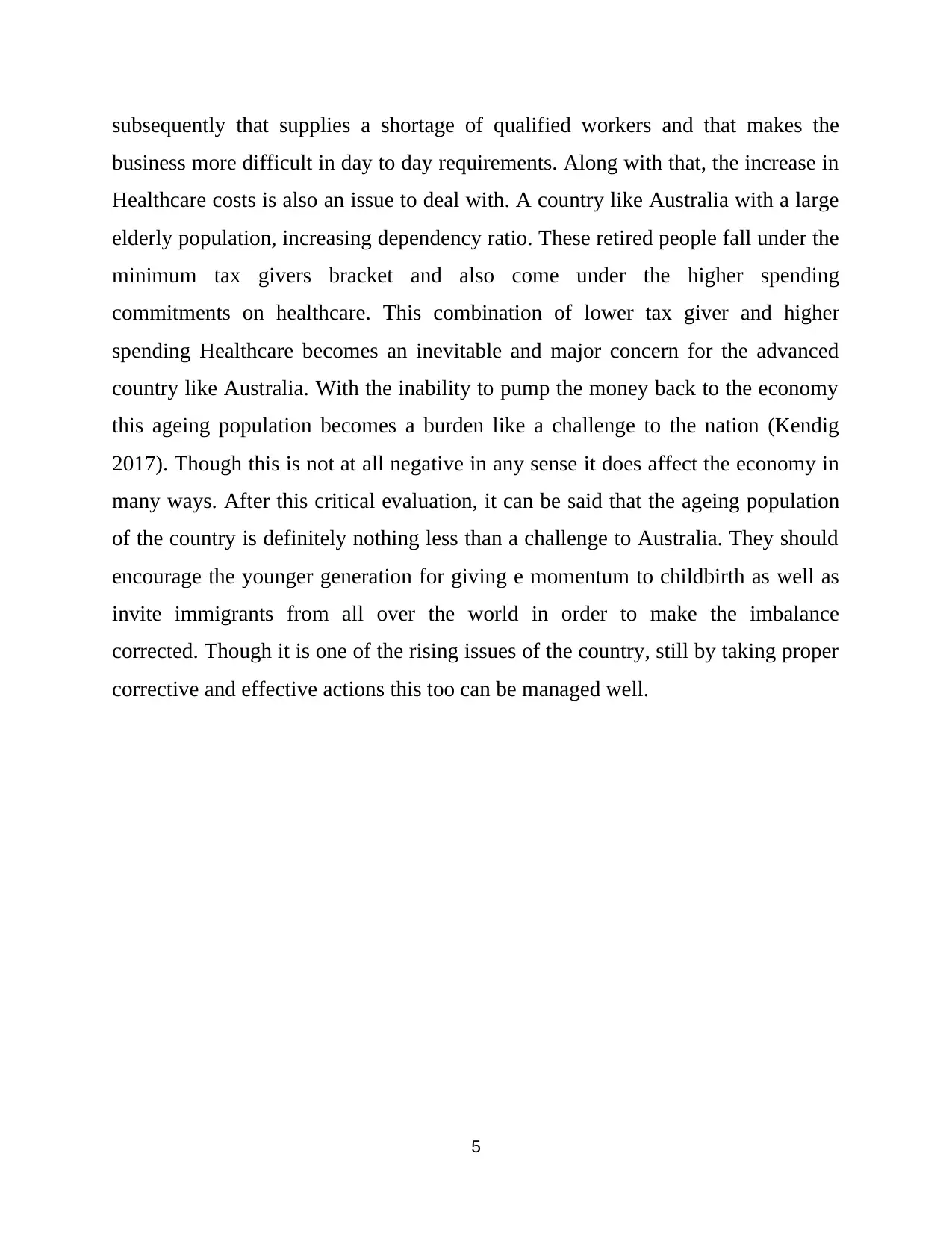
subsequently that supplies a shortage of qualified workers and that makes the
business more difficult in day to day requirements. Along with that, the increase in
Healthcare costs is also an issue to deal with. A country like Australia with a large
elderly population, increasing dependency ratio. These retired people fall under the
minimum tax givers bracket and also come under the higher spending
commitments on healthcare. This combination of lower tax giver and higher
spending Healthcare becomes an inevitable and major concern for the advanced
country like Australia. With the inability to pump the money back to the economy
this ageing population becomes a burden like a challenge to the nation (Kendig
2017). Though this is not at all negative in any sense it does affect the economy in
many ways. After this critical evaluation, it can be said that the ageing population
of the country is definitely nothing less than a challenge to Australia. They should
encourage the younger generation for giving e momentum to childbirth as well as
invite immigrants from all over the world in order to make the imbalance
corrected. Though it is one of the rising issues of the country, still by taking proper
corrective and effective actions this too can be managed well.
5
business more difficult in day to day requirements. Along with that, the increase in
Healthcare costs is also an issue to deal with. A country like Australia with a large
elderly population, increasing dependency ratio. These retired people fall under the
minimum tax givers bracket and also come under the higher spending
commitments on healthcare. This combination of lower tax giver and higher
spending Healthcare becomes an inevitable and major concern for the advanced
country like Australia. With the inability to pump the money back to the economy
this ageing population becomes a burden like a challenge to the nation (Kendig
2017). Though this is not at all negative in any sense it does affect the economy in
many ways. After this critical evaluation, it can be said that the ageing population
of the country is definitely nothing less than a challenge to Australia. They should
encourage the younger generation for giving e momentum to childbirth as well as
invite immigrants from all over the world in order to make the imbalance
corrected. Though it is one of the rising issues of the country, still by taking proper
corrective and effective actions this too can be managed well.
5
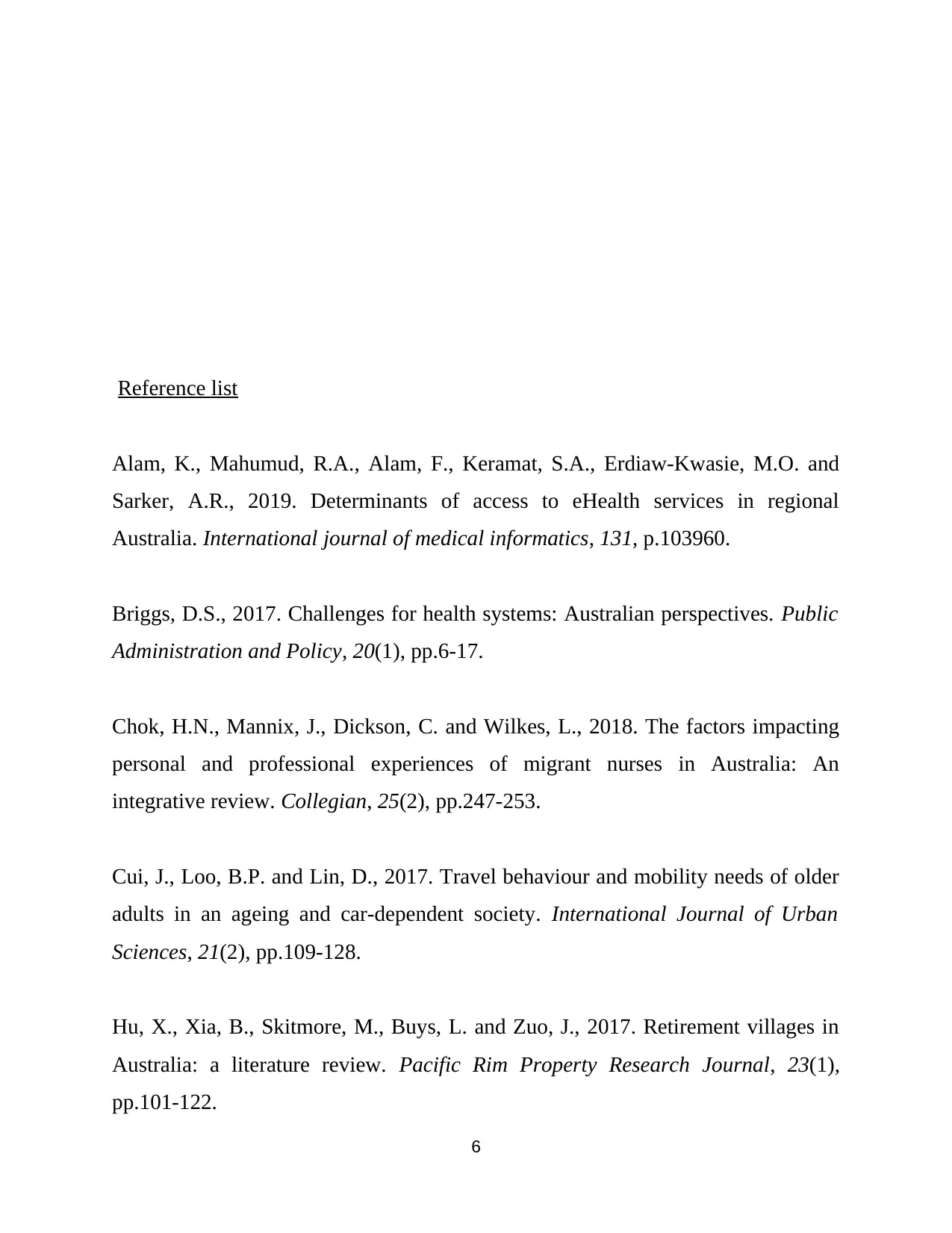
Reference list
Alam, K., Mahumud, R.A., Alam, F., Keramat, S.A., Erdiaw-Kwasie, M.O. and
Sarker, A.R., 2019. Determinants of access to eHealth services in regional
Australia. International journal of medical informatics, 131, p.103960.
Briggs, D.S., 2017. Challenges for health systems: Australian perspectives. Public
Administration and Policy, 20(1), pp.6-17.
Chok, H.N., Mannix, J., Dickson, C. and Wilkes, L., 2018. The factors impacting
personal and professional experiences of migrant nurses in Australia: An
integrative review. Collegian, 25(2), pp.247-253.
Cui, J., Loo, B.P. and Lin, D., 2017. Travel behaviour and mobility needs of older
adults in an ageing and car-dependent society. International Journal of Urban
Sciences, 21(2), pp.109-128.
Hu, X., Xia, B., Skitmore, M., Buys, L. and Zuo, J., 2017. Retirement villages in
Australia: a literature review. Pacific Rim Property Research Journal, 23(1),
pp.101-122.
6
Alam, K., Mahumud, R.A., Alam, F., Keramat, S.A., Erdiaw-Kwasie, M.O. and
Sarker, A.R., 2019. Determinants of access to eHealth services in regional
Australia. International journal of medical informatics, 131, p.103960.
Briggs, D.S., 2017. Challenges for health systems: Australian perspectives. Public
Administration and Policy, 20(1), pp.6-17.
Chok, H.N., Mannix, J., Dickson, C. and Wilkes, L., 2018. The factors impacting
personal and professional experiences of migrant nurses in Australia: An
integrative review. Collegian, 25(2), pp.247-253.
Cui, J., Loo, B.P. and Lin, D., 2017. Travel behaviour and mobility needs of older
adults in an ageing and car-dependent society. International Journal of Urban
Sciences, 21(2), pp.109-128.
Hu, X., Xia, B., Skitmore, M., Buys, L. and Zuo, J., 2017. Retirement villages in
Australia: a literature review. Pacific Rim Property Research Journal, 23(1),
pp.101-122.
6
⊘ This is a preview!⊘
Do you want full access?
Subscribe today to unlock all pages.

Trusted by 1+ million students worldwide
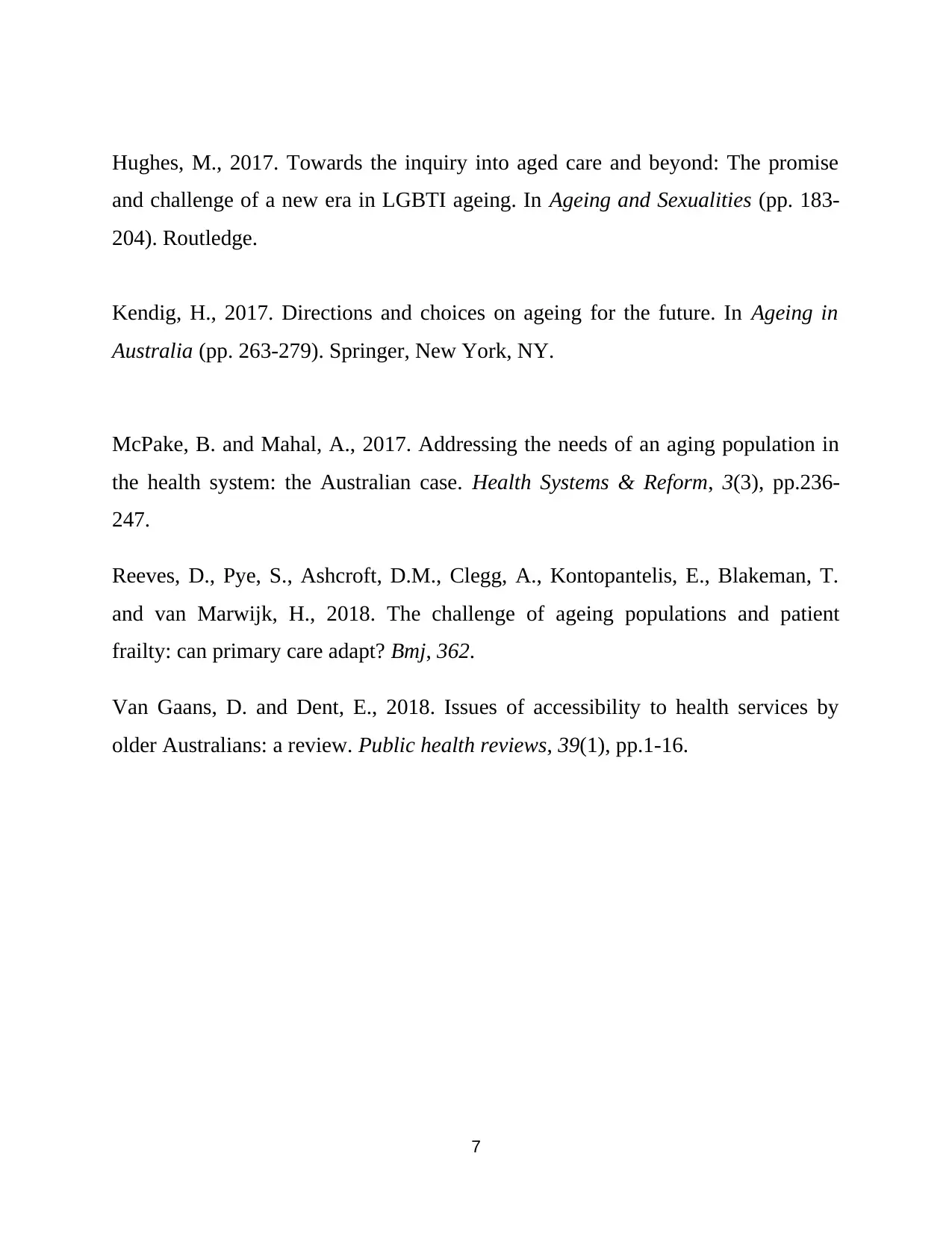
Hughes, M., 2017. Towards the inquiry into aged care and beyond: The promise
and challenge of a new era in LGBTI ageing. In Ageing and Sexualities (pp. 183-
204). Routledge.
Kendig, H., 2017. Directions and choices on ageing for the future. In Ageing in
Australia (pp. 263-279). Springer, New York, NY.
McPake, B. and Mahal, A., 2017. Addressing the needs of an aging population in
the health system: the Australian case. Health Systems & Reform, 3(3), pp.236-
247.
Reeves, D., Pye, S., Ashcroft, D.M., Clegg, A., Kontopantelis, E., Blakeman, T.
and van Marwijk, H., 2018. The challenge of ageing populations and patient
frailty: can primary care adapt? Bmj, 362.
Van Gaans, D. and Dent, E., 2018. Issues of accessibility to health services by
older Australians: a review. Public health reviews, 39(1), pp.1-16.
7
and challenge of a new era in LGBTI ageing. In Ageing and Sexualities (pp. 183-
204). Routledge.
Kendig, H., 2017. Directions and choices on ageing for the future. In Ageing in
Australia (pp. 263-279). Springer, New York, NY.
McPake, B. and Mahal, A., 2017. Addressing the needs of an aging population in
the health system: the Australian case. Health Systems & Reform, 3(3), pp.236-
247.
Reeves, D., Pye, S., Ashcroft, D.M., Clegg, A., Kontopantelis, E., Blakeman, T.
and van Marwijk, H., 2018. The challenge of ageing populations and patient
frailty: can primary care adapt? Bmj, 362.
Van Gaans, D. and Dent, E., 2018. Issues of accessibility to health services by
older Australians: a review. Public health reviews, 39(1), pp.1-16.
7
1 out of 7
Related Documents
Your All-in-One AI-Powered Toolkit for Academic Success.
+13062052269
info@desklib.com
Available 24*7 on WhatsApp / Email
![[object Object]](/_next/static/media/star-bottom.7253800d.svg)
Unlock your academic potential
Copyright © 2020–2025 A2Z Services. All Rights Reserved. Developed and managed by ZUCOL.





